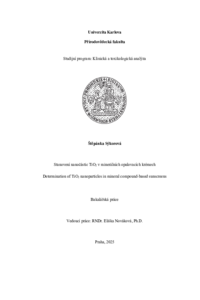Stanovení nanočástic TiO2 v minerálních opalovacích krémech
Determination of TiO2 nanoparticles in mineral compound-based sunscreens
bakalářská práce (OBHÁJENO)

Zobrazit/
Trvalý odkaz
http://hdl.handle.net/20.500.11956/199100Identifikátory
SIS: 270685
Kolekce
- Kvalifikační práce [20864]
Autor
Vedoucí práce
Oponent práce
Hraníček, Jakub
Fakulta / součást
Přírodovědecká fakulta
Obor
Klinická a toxikologická analýza
Katedra / ústav / klinika
Katedra analytické chemie
Datum obhajoby
29. 5. 2025
Nakladatel
Univerzita Karlova, Přírodovědecká fakultaJazyk
Čeština
Známka
Výborně
Klíčová slova (česky)
opalovací krém, nanočástice, ICP-MS, oxid titaničitýKlíčová slova (anglicky)
sunscreen, nanoparticles, ICP-MS, titanium dioxideTato bakalářská práce se zaměřuje na stanovení koncentrace a velikosti nanočástic oxidu titaničitého (TiO2) v pěti komerčně dostupných opalovacích krémech různých značek (Uriage, Nivea, Ladival, Sebamed a Garnier). Pro extrakci TiO2 z krémových matric byly použity tři různé metody převzaté z literární rešerše, které využily různá extrakční činidla (methanol, methanol/hexan, Triton-X100). Extrahované obsahy TiO2 byly porovnány s mikrovlnným rozkladem vzorků. Výsledky ukázaly, že metody extrakce poskytly výrazně odlišné koncentrace TiO2, přičemž nejlepší účinnost vykázala metoda methanol/hexan. U velikostí částic bylo zjištěno, že mediány velikostí převyšují hranici 100 nm, což znamená, že částice nelze považovat za nanočástice podle formální definice. Přesto je pravděpodobné, že nanočástice jsou přítomny ve formě agregátů. Výsledky také potvrzují, že koncentrace TiO2 ve všech vzorcích neporušují legislativní limity stanovené pro kosmetické přípravky. Tato práce přináší efektivní metodiku využití režimu spICP-MS v kombinaci s optimalizovanými extrakčními technikami pro analýzu nanočástic v komplexních kosmetických produktech a podává důkazy o bezpečnosti uvedených vzorků v souladu s platnou legislativou.
This bachelor thesis is focused on determining the concentration and size of titanium dioxide (TiO2) nanoparticles in five commercially available sunscreens of different brands (Uriage, Nivea, Ladival, Sebamed and Garnier). Three different methods taken from a literature search were used to extract TiO2 from the cream matrices using different extraction reagents (methanol, methanol/hexane, Triton-X100). The extracted TiO2 contents were compared with microwave digestion of the samples. The results showed that the extraction methods gave significantly different TiO2 concentrations, with the methanol/hexane method showing the best efficiency. For the particle sizes, the median sizes were found to exceed the 100 nm limit, indicating that the particles cannot be considered nanoparticles according to the formal definition. Nevertheless, it is likely that the nanoparticles are present in the form of aggregates. The results also confirm that the concentrations of TiO2 in all samples do not violate the legislative limits set for cosmetic products. This work presents an efficient methodology for the use of the spICP-MS mode combined with optimised extraction techniques for the analysis of nanoparticles in complex cosmetic products and provides evidence for the safety of these samples in accordance with...
